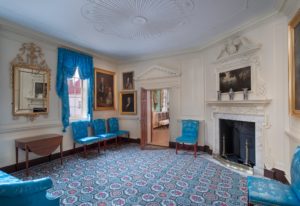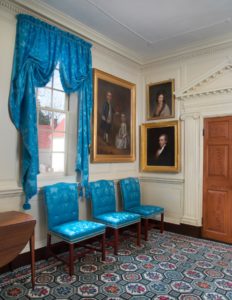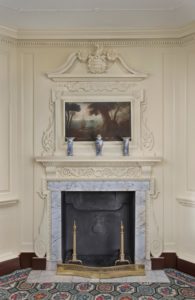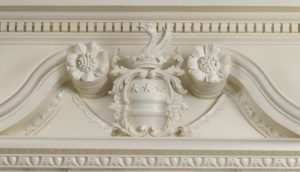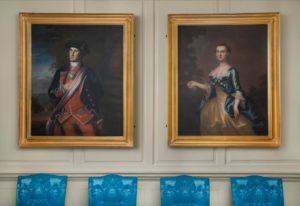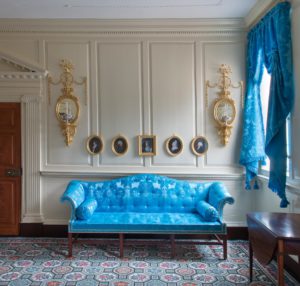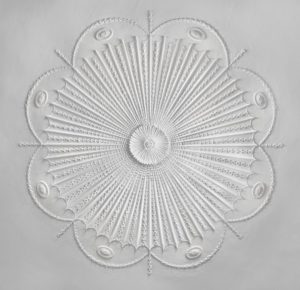Reinterpreting Mount Vernon’s Front Parlor
by Adam T. Erby,
Curator of Fine and Decorative Arts, George Washington’s Mount Vernon
Mount Vernon’s front parlor reopened to guests in February following a major two-year restoration guided by extensive new research. The project returned the room as nearly as possible to its appearance in 1799, the last year of George Washington’s life (Figure 1).
Visitors can now experience the many layers of history present in Mount Vernon’s front parlor, each revealing more about the Washingtons’ lives and the room’s evolution over the course of more than 40 years of their residence. From its earliest iteration during George’s bachelor days through Martha’s growing influence as the lady of the house, the room changed with its occupants, ultimately displaying a lifetime’s worth of cherished portraits and objects. The front parlor once again conveys its elite position as the Washingtons’ primary reception space and restores a glimpse of Martha Washington’s vision for Mount Vernon.
Early Years
Between 1757 and 1759, George Washington elevated the front parlor into the most formal room in the house by adding wood paneling with Palladian features from fashionable pattern books, including the classical engaged pilasters surrounding the doorways and a complex carved mantel and overmantel (Figure 2). He wrote to England to acquire a wood carving of his coat-of-arms to hang between the broken scrolls of the pediment, signifying his genteel status (Figure 3), while he also requested “a neat landskip” painting to hang above the mantel. The overmantel painting is in the style of the famous 17th-century French artist Claude Lorrain, known for his picturesque scenes. This is the first work of art known to have been acquired by George Washington, his choice testifying to his knowledge of the art world and the requirements of polite society.
Martha Washington Enters the Scene
When George married Martha Dandridge Custis in 1759, she brought with her a number of objects that the couple likely used in the front parlor. These included portraits of Martha and her two children from a previous marriage, John Parke and Martha Parke Custis, painted by itinerant English artist John Wollaston in 1757. In 1772, Martha commissioned from Charles Willson Peale the first portrait of George Washington, as a companion to her own. Peale’s painting depicts Washington in an updated version of the uniform he wore as a colonel in the Virginia militia with a mountainous scene in the background, likely alluding to his service in the Ohio River Valley (Figure 4).
A Rediscovered Suite of Furniture
The recent restoration of the front parlor was sparked by the September 2013 acquisition of a previously unknown document, which revealed the appearance of the room’s furnishings. A list titled “Shop Notes” (copies of invoices), kept by their close friend and neighbor George William Fairfax, detailed the extensive furnishings that Fairfax and his wife, Sally Cary Fairfax, purchased for their Virginia home, Belvoir, in 1763, including the contents of an elaborately furnished “blue dressing room” with goods purchased from a London upholsterer. When the Fairfaxes returned to England in 1773, they gave the furniture to George and Martha, who installed it in Mount Vernon’s front parlor. Prior to the discovery of this document, Mount Vernon curators had few details about the appearance of the front parlor furniture beyond the listing in Washington’s probate inventory of a sofa and chairs with mahogany legs.
While none of the original furniture survives, the wealth of details contained in the Fairfax document allowed its appearance to be reconstructed. The suite consisted of a set of eight backstools (expensive chairs upholstered on both the back and seat) and a matching sofa (Figure 5). The entire suite was covered in a “Saxon blue” silk and wool damask, an elaborate use of expensive textiles that made these chairs among the most valuable in the British North American Colonies. The sofa was likely one of the first in Virginia. This seating furniture was far more comfortable than any used at Mount Vernon, and the addition of a sofa allowed a more casual way of sitting. An electric teal blue hue made from indigo and sulfuric acid, Saxon blue began gaining popularity in the 1750s. Viewed in daylight and by candle, the color would have brightened an otherwise dark room, and the silk would have reflected the changing light. The Saxon blue damask would only have been revealed for the most elite guests or on formal occasions. The furniture would have otherwise been shielded under check slipcovers (Figure 6).
Incorporating the Fairfax Suite
When the Fairfax furniture arrived at Mount Vernon, George Washington had already left for the Second Continental Congress. He would not see the furniture in his house until 1781, when he returned briefly en route to the Battle of Yorktown. After the war, the Washingtons integrated the furniture into the parlor, while replacing the room’s Spanish brown and cream color scheme with a “stone” or cream color paint to set off the vibrant blue of the textiles. They also adapted the function of the room to complement the grand New Room added to the north end of the Mansion; the front parlor became an intermediate point in the succession of rooms from the entryway of the central passage to the soaring expanse of the New Room. To visually unite the two spaces, George Washington turned to John Rawlins, the Baltimore stuccoman employed to decorate the New Room, to also update the front parlor with the elaborate Neoclassical ceiling visible today (Figure 7).
While this work was underway, the Washingtons received a new painting, a group portrait of the Marquis de Lafayette and his family, that they likely hung in a place of honor above the sofa. The Marquis commissioned the portrait and sent it to George and Martha Washington as a gift immediately after the American Revolution. A visitor recorded what must have been an arresting family picture, describing that “The Mar[quis] in an American uniform is presenting to his wife…his son aged 4 also in an American uniform; his two daughters nearly the same age complete the group.” Unfortunately, the painting remains unlocated with the empty spot above the sofa suggesting where it may have hung.
The Classical Taste After the American Revolution
After the American Revolution, the latest British trends in architecture and interior decoration began to flood into the former colonies. The Washingtons were at the forefront of this shift in taste, adding Neoclassical plasterwork to the New Room and front parlor in the mid-1780s, and they continued to keep pace with prevailing trends for the rest of their lives. The Washingtons updated the front parlor again at this time, completing the Neoclassical transformation. From Philadelphia, they brought an elaborate looking glass, a pair of mirrors and brackets to hold Argand lamps, several new portraits, and a carpet. Additionally, they replaced the frames on a number of portraits to bring them up-to-date. Although several of these objects survive in fragmentary form in other collections, they have not been previously represented in the parlor.
One of the most impressive of these pieces is the large pier glass between the two windows, a reproduction of an English example the Washingtons purchased for use in the President’s House in Philadelphia that they brought with them when they returned to Mount Vernon (Figure 8). The original descended in Eleanor Parke “Nelly” Custis Lewis’s family and survives today in the Smithsonian’s collection, though it has lost much of its ornament. Looking glasses reflected the social standing of owners, and few in 18th-century America were more elaborate than this one, with its large central pane bordered by eight smaller panes set in a gilt frame and crowned by a delicate crest consisting of a classical urn, foliage, and bellflowers.
The Washingtons also installed a pair of girandoles, or “mirrors and brackets,” to hold Argand lamps that reflected light into the room (Figure 9). Elements of the original pieces survive in disparate collections, linked together by finish analysis. George Washington’s use of Argand lamps on these mirrors and brackets highlighted his interest in new lighting technologies. These lamps, two from a set of fourteen, are in the shape of Neoclassical urns and, when sitting on the brackets, they fill the mirrors behind them.
Freshening Up the Family Portraits
Prior to the Washingtons’ return from Philadelphia, the portraits in the front parlor likely contained a medley of frames in various styles. George wrote to his farm manager requesting the sizes of the paintings so that he could purchase new frames in Philadelphia and unify the Neoclassical appearance of the room. Although the original frames no longer survive, a “gilt” Neoclassical example, in common use in Philadelphia during the 1790s, provided an appropriate model for new frames housing the likenesses of George, Martha, and the Custis children.
At the conclusion of his presidency, George Washington commissioned from the renowned English portrait painter James Sharples profile portraits of his two namesakes—his adopted grandson, George Washington Parke Custis, and George Washington Motier de Lafayette. Sharples created these portraits using a physiognotrace, an instrument invented in France during the previous century, to trace a facial profile. He then filled in the face and body with his characteristically delicate pastel crayons, capturing the subtle details of each sitter’s face. The Washingtons also acquired Sharples portraits of George, Martha, and Eleanor Parke Custis.
The room features portraits of lesser-known members of the Washington family, highlighting their presence at Mount Vernon (Figure 10). Thomas Law, a handsome Englishman who had served as a government official in India, likely commissioned his portrait from Gilbert Stuart and presented it to the Washingtons as a gift after he married Martha’s oldest granddaughter, Elizabeth Parke Custis in 1796. The original painting hung in the room until Martha’s death. Frances (Fanny) Bassett Washington, Martha’s niece, was painted by English artist Robert Edge Pine during a 1785 visit to Mount Vernon. Fanny married George’s nephew in 1785 and lived at Mount Vernon, where she raised her children and helped Martha maintain the household and entertain guests. Both of these portraits have been conserved and rehoused in new frames that approximate the appearance of the now-lost originals.
Conclusion
After a comprehensive restoration, the front parlor’s successive layers are once again evident. As the Washingtons grew older, they altered the room and added objects to meet their changing needs and tastes. Although George Washington began to decorate the room, he created only its shell prior to his marriage. The parlor was the domain of the lady of the house, the space where Martha presided over the tea table and welcomed guests. She took the lead in changing the furnishings, commissioning portraits, and creating a room that truly reflected their family. Here, more than almost any other spot in the Mansion, we can see a room through Martha Washington’s eyes and better understand the key role she played in making Mount Vernon a stylish home.

